Sea turtles are undoubtedly one of the most popular animals in the ocean, especially considering they love warm water and can be found worldwide in tropical and subtropical waters. Whether snorkeling or diving, turtles are always a highlight of any trip. Sea turtles are built for the ocean. They have existed there for over 100 million years, so their bodies are perfectly streamlined for swimming. Unlike land turtles, sea turtles cannot retract their head into their shell. Being a reptile, turtles are air breathers, meaning they need to surface for air when they have to breathe and cannot breathe underwater, although they can stay underwater for a pretty long time before surfacing for air. One species, the Green Sea Turtle (Chelonia mydas) can hold its breath up to five hours, but normal trips to and from the surface while feeding last usually less than ten minutes.
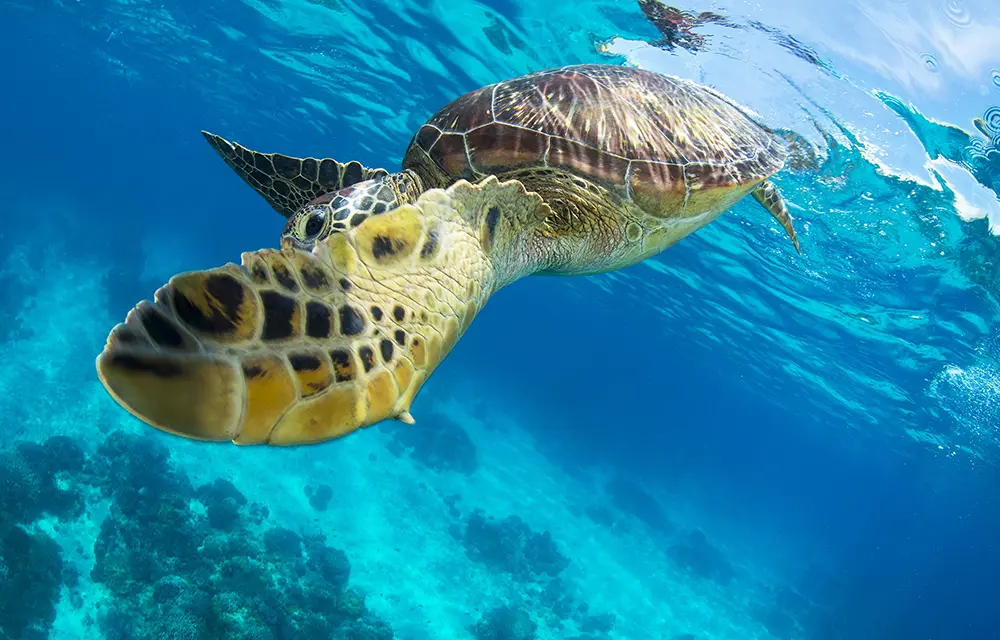
Photo: Yorko Summer
Sea turtles spend most of their lives underwater and only come on land to lay eggs. In rare instances, a turtle will crawl on land if it has an injury, such as a large shark bite. They are capable of swimming massive distances, especially when migrating from feeding grounds to nesting grounds. There was a turtle tagged in the Philippines this year that swam all the way to Hawaii. There is research that shows there are some Loggerhead Sea Turtles (Caretta caretta) that nest in Japan and then migrate to Mexico to feed, so sea turtles are able to swim thousands of kilometers to reach a destination, in this case around 10,000 km. Sea turtle nesting grounds can be found all over tropical and subtropical beaches, although the Leatherback Sea Turtle (Dermochelys coriacea) can withstand water temperatures below 40˚F/4.5˚C.
Sea turtle mating? This is how it’s done
Once a female sea turtle is sexually mature, which can take anywhere from 15-50 years depending on the species and research you are reading, she will crawl onto a beach to lay eggs, usually at night. Although sea turtles may try and return to the beach where they were born, sometimes successfully, it is not always possible due to noise pollution, light pollution, and/or coastal development. Sea turtles prefer beaches next to sand dunes that are quiet, safe, and shaded from any light since the baby sea turtles, called hatchlings, emerge at night. They primarily depend on the reflection of the moon and stars on the ocean surface to guide them once they hatch, in addition to olfactory (smell) and magnetic cues. Sometimes they get disoriented from street lights or buildings and crawl the wrong way. Once a sea turtle finds an adequate spot for a nest, she will begin to dig using her rear fins. This nest can be pretty deep as it needs to fit an incredible number of eggs, anywhere from 75-200 depending on the species, although the average is closer to 100. A female sea turtle will nest multiple times in a season, a week or more apart, but will not return for at least a year or more before she nests again. Many times female turtles will ‘cry’ when they lay eggs, called turtle tears, but this is just the turtle secreting salt that has accumulated in her body.
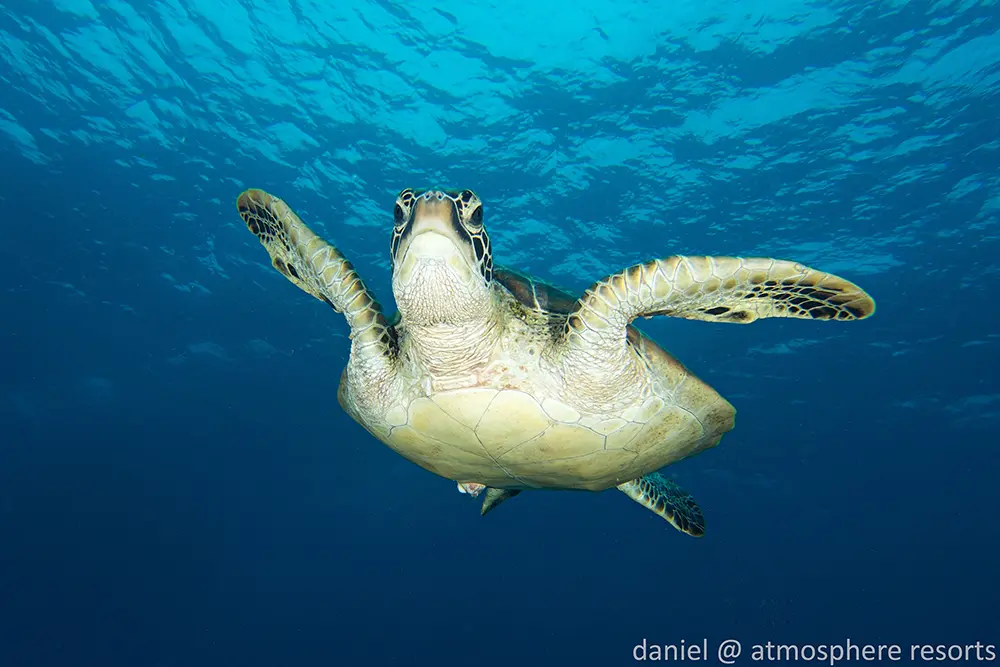
Green sea turtle
After about two months, the hatchlings will all emerge simultaneously and make a mad dash to the ocean. The temperature of the nest actually decides whether eggs will be male or female. By having deep nests and nesting over a number of months, this ensures a healthy distribution of genders, even within a single nest or from a single turtle. Although it changes depending on the species, warmer temperatures usually produce females and colder temperatures usually produce males. Not all of the hatchlings escape from their eggs at the same time, using a specialized tooth called a caruncle. Those that hatch earlier will wait for their siblings so that they can make the journey together. By emerging at the same time, referred to as the predator satiation effect, this increases the chances of survival for at least some of the turtles. If each hatchling crawled towards the ocean one at a time, each would surely be picked off by a predator. By crawling together, many of the turtles will still be victims of predation, but those predators feeding on them will become satiated, or full, and leave the rest alone. Hatchlings have a tough life ahead of them as they have to swim several miles to the sargassum mats, large patches of floating seaweed, for safety. From the minute they are born, hatchlings are potential prey for anything from crabs, birds, sharks, even ants that may crawl into the nest before they hatch. The trip to the ocean is so exhausting that some even succumb to dehydration and dry out in the sun. It is said that anywhere from 1 in 1,000 or 10,000 reach adulthood.
Plastic is the sea turtle’s worst enemy
Sea turtles are facing many threats in the ocean, almost all of them caused by humans. As stewards of the environment, there are a few things we can do to reduce our impact on the ocean and, specifically, sea turtles. One of the worst threats to turtles is plastic, especially plastic bags. When they are floating in the water they look very similar to jellyfish and many turtles will ingest them, which can block the turtles’ digestive systems and result in death. A great way to combat this problem is to bring cloth bags or use paper bags when out shopping and to overall decrease your plastic use, including straw, utensils, basically any single-use items. In some areas, sea turtles are still victims of poaching. They are also victims of bycatch, the unintended capture of a non-targeted species, and can get stuck in trawling nets or caught on hooks. Sea turtles are also facing threats from coastal construction which replaces or destroys prime nesting areas. Areas with coastal construction produce light and noise pollution, causing available nesting areas to become undesirable to sea turtles. If you live or are vacationing in known nesting areas, make sure you turn off your outside lights and close any window blinds or shutters. Also remember to keep the noise down to a minimum, so no beach parties during nesting season! If you have children who like to dig holes and make sand castles on the beach, please flatten the sand or fill the holes before leaving in the afternoon as sea turtle hatchlings can fall into the holes and get stuck. Remember to put away all of your beach furniture, such as chairs and umbrellas, as these can get in the way of nesting turtles and sometimes they even get entangled in them.
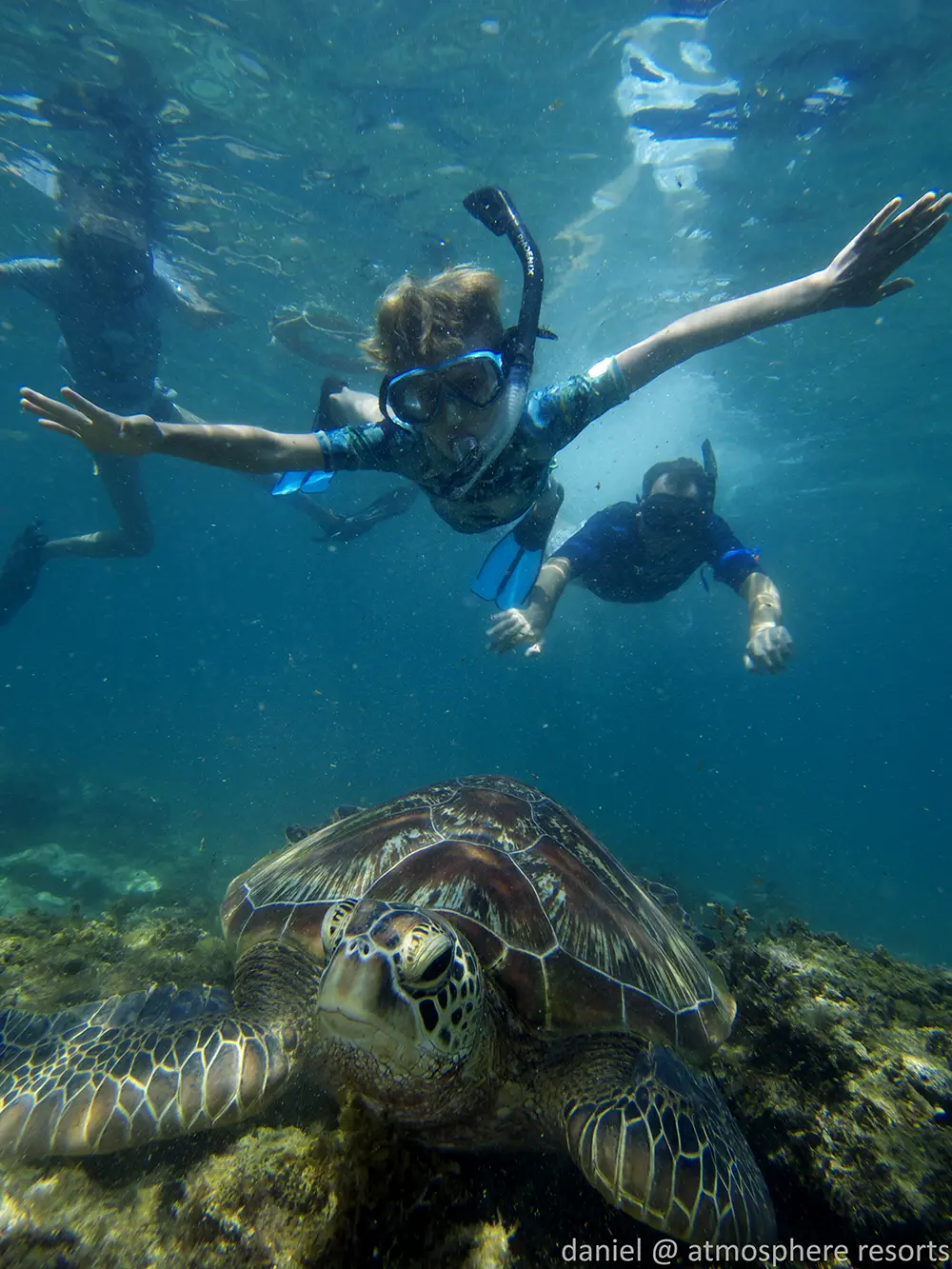
We want to keep seeing kids swim with turtles, so make sure their environment is kept garbage free!
When you are snorkeling or diving with sea turtles, please remember not to touch them and to give them a bit of personal space. Many sea turtles will allow people to get very close, but if a turtle begins to swim away and turns its shell towards you, that a sign that it is feeling threatened and you should probably leave it alone. If you encounter a female turtle nesting on the beach at night, it is also important to give her some space. A female needs a quiet, dark area to feel comfortable when she crawls ashore. If you are on a beach specifically for observing nesting sea turtles, remember not to use a flashlight around then. If you want to get a better view, use a red light or a red filter instead as it will not disturb the turtles. While observing, don’t block the path to their nesting areas or their return to the ocean, and stay behind them when they are laying eggs so they are not disturbed.
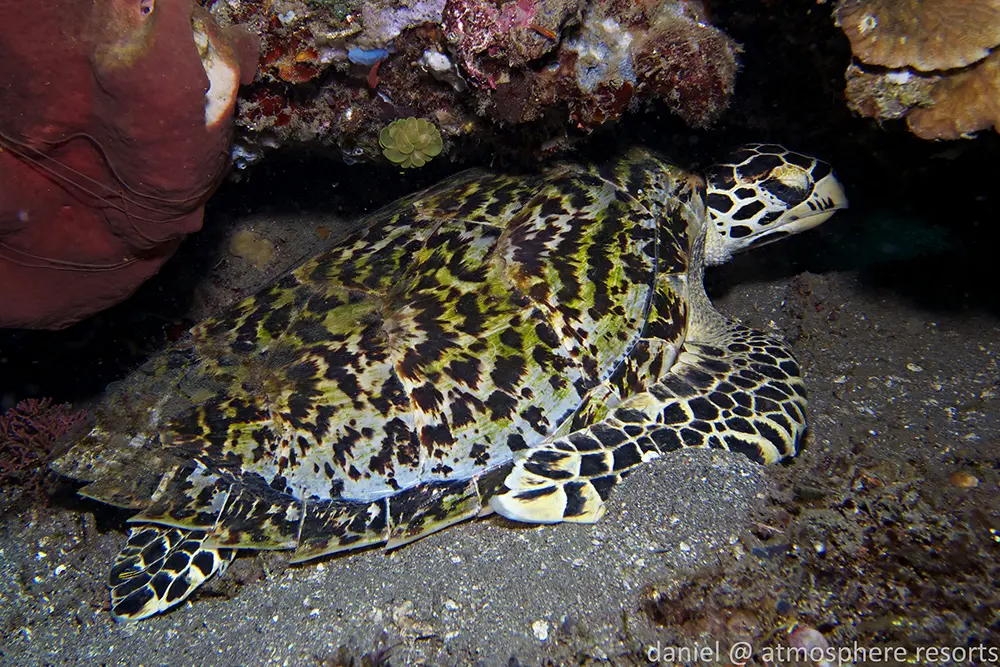
Sea turtle tourism? Do your homework…
Luckily there are many people that are working towards efforts to save turtles and spread awareness. There are plenty of turtle hospitals in the United States and in other countries around the world that educate guests at aquariums as well as perform turtle surgeries, nest and hatchling surveys, and turtle rehabilitation. Unfortunately, some organizations and tourist activities that promote turtle conservation may actually be harming the species. One of the best examples is the activity of tourists paying to release their own hatchlings. Turtles need to be released directly into floating seaweed miles offshore to increase their chances of survival instead of being released one by one where there is no safety in numbers. When you are visiting anywhere that involves sea turtle tourism, make sure you research the project or the activity and see who they are associated with, what their main projects and goals are, and if they have a mission statement.
We at Atmosphere Resorts & Spa do everything necessary to protect our turtles at Apo Island. We reduce the amount of plastic we use, such as not selling any plastic bottled water. Straws are only given out upon request and those that we do give out are decomposable. We have reusable plastic boxes in our kitchens, we recycle all our garbage, and we stock the bathrooms with refillable, locally-sourced ceramic soap containers instead of travel sized plastic bottles. Additionally, we encourage all our divers to keep the ocean clean and to pick up any plastic or other garbage we find on every dive.
Win a sea turtle trip to Atmosphere in the Philippines
Atmosphere Resorts & Spa has donated an amazing trip to the Philippines, especially to Apo Island to dive and snorkel with the sea turtles to support the Turtle Foundation. For those feeling lucky, please take part in the raffle at the booth of WeDive Travel AG during the FESPO (26 – 29 January) in Zurich and support the Turtle Foundation with your ticket.
With the great work the Turtle Foundation is doing in Indonesia we believe that there is a chance that some of the turtles they are saving may migrate to Apo Island or even towards our house reef as their future home and feeding ground.

The seven species of sea turtles in the world
Green Sea Turtle (Chelonia mydas)
This turtle is the most common sea turtle seen by snorkelers and divers. They have a bullet-shaped head and reach a maximum size of around 1.5 meters. They can weigh at least 160 kg and it is estimated that they have a lifespan of 80-100 years. The largest ever recorded was nearly 400 kg! Their diet consists of plants, such as algae and seagrass, as well as sponges. They have a worldwide distribution.

Photo: Daniel Geary
Hawksbill Sea Turtle (Eretmochelys imbricata)
Another common turtle, this species has a sharp beak, hence the name hawksbill. They reach a maximum length of around 75 centimeters and maximum weight around 70 kg. Their diet consists of hard coral, sponges, sea urchin, sea anemones, and other small animals. They have a worldwide distribution, though normally restricted between the latitudes 30N and 30S, making them a tropical turtle. They are thought to live 30-50 years.

Loggerhead Sea Turtle (Caretta caretta)
This species is characterized by its very large head and is the most common turtle in the United States, especially in Florida. Adults normally reach lengths of around 1.1 meters and weigh at least 170 kg. Their diet consists of hard-bodied animals, like crabs, whelks, and sea urchins. They have a wide distribution and are found in the Atlantic, Pacific, and Indian oceans. It is believed they can life at least 50 years.
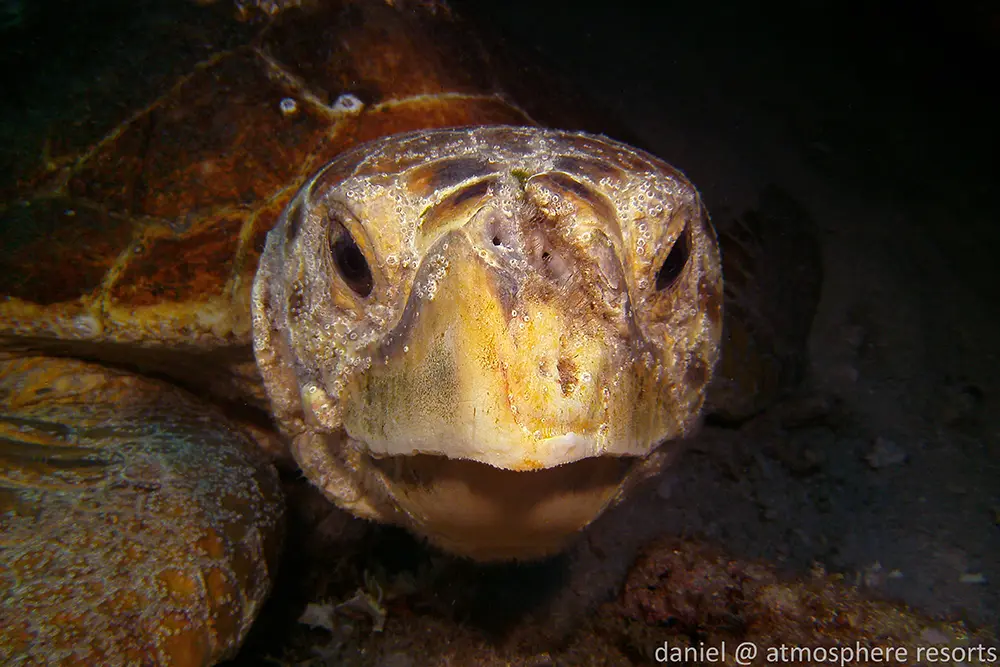
Leatherback Sea Turtle (Dermochelys coriacea)
This is the largest turtle in the ocean. It is nearly all black and has ridges on its back beneath a leathery cover instead of a normal turtle shell which makes this species suitable for diving into deeper water. They can reach lengths of at least 1.8 meters and weigh over 500 kg. The largest ever recorded was 3.05 meters and weighed 916 kg! Their diet exists almost exclusively of jellyfish. Their main habitat is the open ocean, rarely coming near shore except during nesting season. They have the largest distribution of all species as they can be found worldwide as well as further north and south than the Green Sea Turtle. It is believed they live at least 30 years.
Olive’s Ridley Sea Turtle (Lepidochelys olivacea)
This is one of the smaller species of sea turtles. They reach a maximum size of around 70 centimeters and can weigh around 45 kg. Their diet consists of crustaceans, molluscs, and some small fish. They are normally found in bays and coastal estuaries but do swim offshore to feed. Their distribution includes the tropical and subtropical waters of the Pacific, Indian, and Atlantic oceans, although they are now considered rare in the Indian Ocean as well as the Western Pacific Ocean. They nest in arribadas, which is when thousands of sea turtles crawl on land simultaneously to lay eggs. It is believed they live up to 50 years.
Kemp’s Ridley Sea Turtle (Lepidochelys kempii)
Another small species, this turtle is characterized by its triangular shaped head. They reach a maximum length of around 70 centimeters, and a maximum weight of around 49 kg, very similar to the Olive’s Ridley Sea Turtle. Their diet consists of crustaceans, clams, and mussels. They have a very small distribution as they are primarily found in the Gulf of Mexico but can also be found on the East Coast of the United States. They also nest in arribadas. It is believed they live up to 50 years.
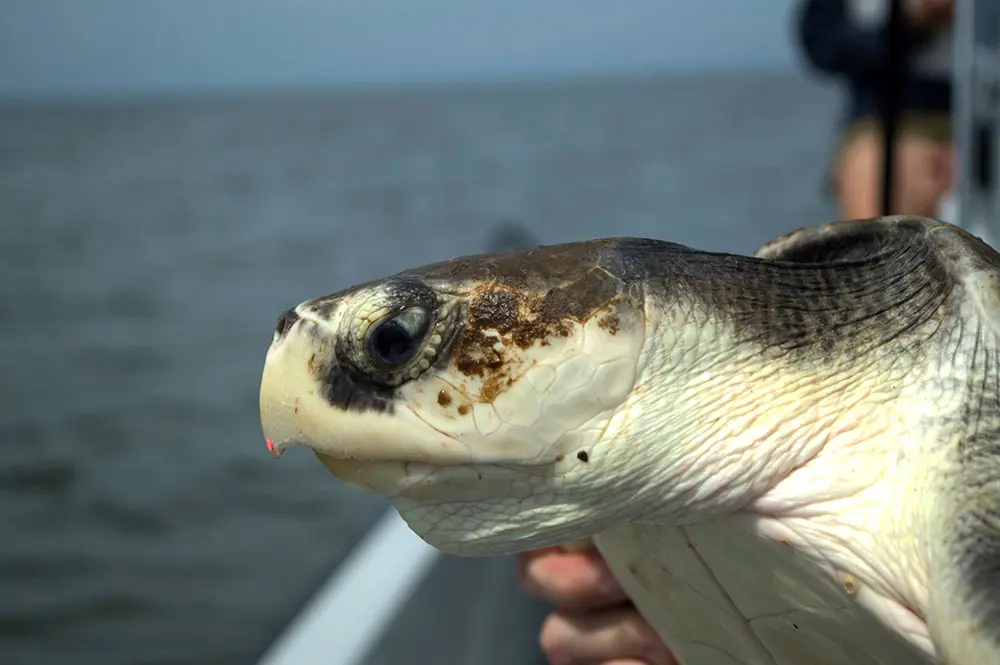
Turtle legally captured under NMFS permit #17183-02
Flatback Sea Turtle (Natator depressus)
This species is characterized by its very flat shell. They can reach a maximum length of around 1 meter and a maximum weight of about 90 kg. Their diet consists of invertebrates such as jellyfish, sea cucumbers, as well as some crustaceans. They have a small distribution and are only found near Australia and Papua New Guinea.
Your marine biologist /Daniel Geary
Photos by Daniel Geary and Allard van der Graaf







SEA TURTLES are awesome!!Thanks for the inspiration for my new book.I am a LEGENDARY AUTHOR!!!!!